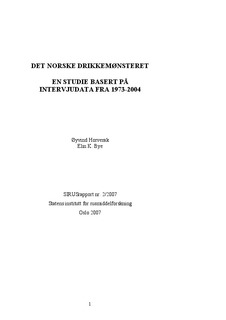| dc.contributor.author | Horverak, Øyvind | |
| dc.contributor.author | Bye, Elin Kristin | |
| dc.date.accessioned | 2015-01-29T13:55:32Z | |
| dc.date.accessioned | 2015-02-11T18:46:32Z | |
| dc.date.available | 2015-01-29T13:55:32Z | |
| dc.date.available | 2015-02-11T18:46:32Z | |
| dc.date.issued | 2007 | |
| dc.identifier.citation | SIRUS-rapport. 248 p. Statens institutt for rusmiddelforskning, 2007 | |
| dc.identifier.isbn | 978-82-7171-299-0 | |
| dc.identifier.uri | http://hdl.handle.net/11250/275879 | |
| dc.description | - | |
| dc.description.abstract | Forbruket vil øke
- Dagens eldste drikker mindre enn generasjonene som kommer etter dem. Derfor vil alkoholforbruket i Norge med all sannsynlighet fortsette å øke i årene framover. Hvor lenge økningen vedvarer er avhengig av hvilket forbruksnivå yngre generasjoner legger seg på, sier Horverak.
Økningen i alkoholforbruket fra 1979 til 2004, skyldes at nye generasjoner drikker mer enn generasjonene før dem gjorde da de var på deres alder. Nye generasjoner drikker seg også oftere beruset enn generasjonene før dem.
De yngste går mer ut
Nordmenns foretrukne drikkested er hjemme eller hjemme hos andre. Unntaket er de yngste aldersgruppene. Fra 1991 til 2004 økte antall ganger 26-30 åringene besøkte utesteder med 70 %, og en noe svakere økning på de mellom 18 og 25 år. For aldersgruppene over 30 år har derimot besøket vært stabilt. I samme periode har antall skjenkesteder økt med ca 50 %. Det økte antall utesteder tiltrekker seg derfor i hovedsak et ungt publikum.
Fra hjemmebrent til taksfri og grensehandel
Hjemmebrent og til dels hjemmelaget vin dominerte på 70-tallet den alkoholen som ikke ble kjøpt inn på Vinmonopolet og i norske butikker og skjenkesteder. Nå er det derimot taksfri og grensehandel som dominerer det uregistrerte forbruket. Andelen som har handlet taksfri har økt fra 29 til 55 % fra 1979 til 2004, og andelen som har handlet i Sverige ble økte fra 9 til 22 % fra 1994 til 2004. Derimot var det kun 15 % som drakk hjemmebrent i 2004 mot 50 % i 1973.
Sosiale skiller
Det er en klar sammenheng mellom sosial klasse og drikkemønster. Funksjonærer drikker hyppigst, mens arbeidere drikker mer når de drikker. De drakk seg beruset ca hver fjerde gang de drakk, mens funksjonærene gjorde det ca hver sjette gang. Sosial tilhørighet har også betydning for om man foretrekker øl eller vin. Arbeidere har tradisjonelt drukket mer øl og funksjonærer mer vin. For alle grupper unntatt studenter har vinforbruket økt i perioden 1994 til 2004, mens brennevinforbruket har gått ned. Studenter har et mer ruspreget drikkemønster enn andre grupper: de drikker sjeldnere, men mer hver gang. | |
| dc.description.abstract | Since 1962 the Norwegian Institute for Alcohol and Drug Research has collected data about drinking habits from representative samples of the Norwegian population. The surveys have been carried out approximately every five years; last time in 2004. The first studies were limited to questions about drinking frequencies, but since 1973 people have been asked how much they usually drink of different types of alcoholic beverages during a drinking session. On the basis of questions about frequencies and quantities consumed, it was possible to estimate average alcohol consumption during the last year, and to give a description of changes in average alcohol consumption per year from 1973 to 2004.
Since 1973 the respondents have also answered questions about quantity of alcohol consumed during the last drinking occasion. Based on the assumption that these last drinking occasions were representative for the way Norwegians used to drink alcoholic beverages, it was possible to analyse changes in the drinking pattern from 1973 to 2004.
It is a well-known fact that quantity of alcohol consumed during a drinking occasion is linked to the context of the occasion. Therefore, questions about where the last drinking occasion took place, and the number of participating persons were included in the survey instrument. This gave us an opportunity to analyse in which way the amount consumed is linked to contextual variables.
The first part of the report, chapters 1-4, discusses the content of the term “drinking pattern”, in relation to terms like drinking culture, drinking customs and drinking habits. In this part we draw on Bourdieu’s theories of the structure and formation of society. We reserve the term drinking pattern as a quantitative measure suitable to describe the way alcohol is consumed among a group of people; i.e. the drinking pattern consists of a set of values on a number of defined variables: average drinking frequency, average amount per drinking occasion, the share of the drinking occasions, which may be termed binge drinking, the distribution of the consumption among the different alcoholic beverages, weekly drinking rhythm, and some contextual variables.
In chapter 5 the data base is described, while an analysis of the changes in the number of non-drinkers (people who have not consumed alcohol last year) is described in chapter 6. The share of non-drinkers fell from 32% in 1956 to 17% in 1966, and decreased further to 13% in 2004. It was a little bit more usual to drink alcohol among men than women, but the differences between genders tended to be smaller and smaller during the whole period. In 2004, 15% of women and 11% of men said that they had not consumed any alcoholic beverage during the last year. | |
| dc.language.iso | nob | |
| dc.relation.uri | http://www.sirus.no/filestore/Import_vedlegg/sirusrap.2.07.pdf | |
| dc.title | Det norske drikkemønsteret. En studie basert på intervjudata fra 1973-2004 | |
| dc.title.alternative | The Norwegian drinking pattern | |
| dc.type | Research report | |
| dc.date.updated | 2015-01-29T13:55:32Z | |
| dc.identifier.cristin | 1064512 | |
